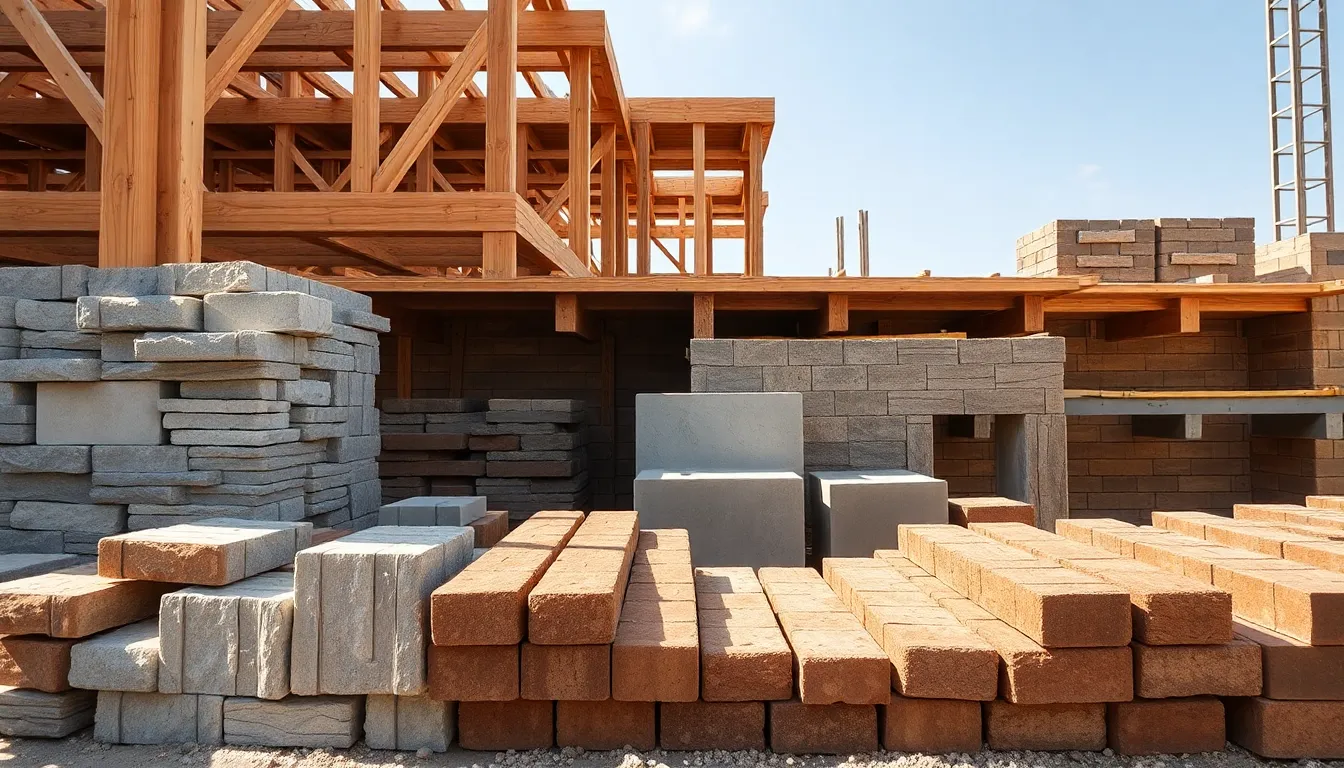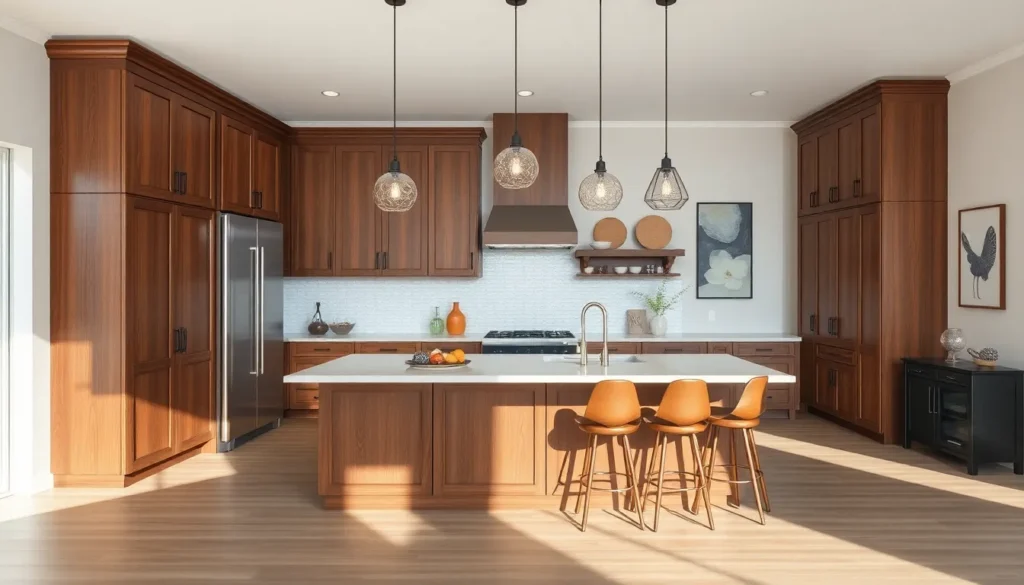In the ever-evolving world of construction, material choices play a pivotal role in determining the success of any project. From sustainability to durability, the right materials can enhance not just the aesthetic appeal but also the overall functionality of a building. As architects and builders face increasing demands for eco-friendly solutions, understanding the various options available has never been more crucial.
Navigating through the vast array of construction materials can be daunting. Each choice carries implications for cost, longevity, and environmental impact. This article delves into the key considerations when selecting construction materials, offering insights that help make informed decisions. Whether embarking on a new build or a renovation, knowing the strengths and weaknesses of different materials can lead to more efficient and sustainable outcomes.
Table of Contents
ToggleOverview of Construction Material Choices
Construction material selection directly influences a project’s sustainability, durability, and functionality. Various materials provide unique benefits and drawbacks, making informed decisions essential.
Common Material Categories
- Wood
Wood serves as a traditional choice for framing and flooring. It’s renewable, offers good insulation, and adds aesthetic appeal. However, it requires treatment for pests and moisture resistance.
- Concrete
Concrete excels in strength and longevity. Its durability makes it ideal for foundations and infrastructure. Despite its high carbon footprint during production, innovations in green concrete are emerging.
- Steel
Steel boasts exceptional strength and flexibility. It’s highly recyclable, making it a sustainable option. While initial costs may be higher than alternatives, steel’s longevity can reduce overall lifetime expenses.
- Brick
Brick provides fire resistance and thermal mass benefits. It’s widely used in load-bearing walls. Brick’s production involves significant energy, but its durability can outweigh environmental impacts over time.
- Glass
Glass enhances aesthetics and natural light entry. It’s often used in facades and windows. Innovations in energy-efficient glazing can minimize heat loss, improving sustainability.
Key Considerations in Material Selection
- Cost
Cost influences material choices significantly. Evaluating both initial expenses and lifecycle costs ensures economic viability.
- Longevity
Lifespan affects maintenance needs and replacement frequency. Durable materials reduce long-term costs and environmental impacts.
- Environmental Impact
Assessing the ecological footprint of materials promotes sustainable building practices. Selecting locally sourced or recycled materials lowers transportation emissions and conserves resources.
- Performance
Materials should meet specific performance standards, including strength, insulation, and moisture resistance. Understanding how each material performs under various conditions aids in making appropriate selections.
- Aesthetics
Visual appeal can influence project success. Material choices can enhance or detract from the overall design, affecting client satisfaction.
By carefully considering these factors and material characteristics, architects and builders can make choices that lead to successful and sustainable construction projects.
Types of Construction Materials

Construction materials fall into two main categories: natural and synthetic. Each type offers distinct characteristics that influence project outcomes.
Natural Materials
Natural materials include wood, stone, and clay.
- Wood: Wood is renewable and provides excellent insulation. It requires treatment to resist pests and moisture.
- Stone: Stone boasts durability and low maintenance, often used for aesthetics and structural strength. However, it’s heavy and costly to transport.
- Clay: Clay is widely used in bricks and tiles. It has low thermal conductivity and is abundant, though its production can be energy intensive.
Natural materials promote sustainability and often have lower environmental impacts due to their inherent properties.
Synthetic Materials
Synthetic materials encompass concrete, steel, asphalt, and plastics.
- Concrete: Concrete offers high compressive strength and durability, making it a favorite in foundations and structures. It has a substantial carbon footprint, but innovative green alternatives are emerging.
- Steel: Steel provides exceptional strength-to-weight ratios and is 100% recyclable, which makes it a popular choice for modern constructions. It can rust without proper treatment, necessitating maintenance.
- Asphalt: Asphalt is essential for pavement and roofing. Its ability to withstand weathering and easy installation makes it cost-effective, but it’s derived from petroleum, raising environmental concerns.
- Plastics: Plastics are versatile and lightweight, useful for piping and insulation. They can, however, contribute to long-term environmental issues due to slow decomposition.
Synthetic materials, while often versatile and durable, can pose environmental challenges, necessitating careful selection and management.
Factors Influencing Material Selection
Material selection in construction hinges on several critical factors. Understanding these influences ensures architects and builders choose the most suitable materials for their projects.
Cost Considerations
Cost plays a pivotal role in material selection. Architects and builders evaluate not only the initial purchase price of materials but also their long-term financial implications. Initial costs include material prices, shipping, and installation, while lifecycle costs encompass maintenance, replacement, and energy efficiency over time. For instance, while concrete might have a higher upfront cost, its durability can result in lower maintenance expenses, making it a cost-effective choice in the long run.
Environmental Impact
Environmental impact significantly influences material choices. Architects and builders seek materials that minimize ecological footprints. Natural materials, like wood and stone, often have lower environmental impacts compared to synthetic options. Furthermore, manufacturers increasingly offer eco-friendly alternatives, such as recycled steel and low-emission concrete. Selecting materials with sustainable certifications or those produced through environmentally friendly processes contributes to greener construction practices while meeting regulatory standards.
Durability and Maintenance
Durability and maintenance considerations affect the longevity of construction materials. The lifespan of materials varies, with wood requiring more maintenance than stone or steel. Durable materials, such as steel and concrete, often withstand harsh conditions better, reducing the frequency of repairs and replacements. Assessing the potential for wear and tear helps architects and builders choose materials that not only meet performance expectations but also align with long-term sustainability goals.
Innovations in Construction Materials
Recent advancements in construction materials focus on sustainability and smart technologies. These innovations aim to enhance the efficiency and ecological footprint of construction projects.
Sustainable Materials
Sustainable materials prioritize environmental stewardship while maintaining performance. Options like bamboo and recycled metals offer eco-friendly alternatives to traditional construction materials. Bamboo, a rapidly renewable resource, provides high strength-to-weight ratios and enhances aesthetic appeal. Recycled metals, such as aluminum and steel, significantly reduce resource extraction impacts and energy consumption during production.
Bio-based materials, like hempcrete and mycelium, contribute to sustainability by utilizing agricultural waste and renewable resources. Hempcrete, made from hemp fibers, is lightweight, provides insulation, and absorbs carbon dioxide during its lifecycle. Mycelium, derived from fungi, can be used as a biodegradable building block, contributing to waste reduction and energy efficiency.
Moreover, innovations in concrete technology, such as geopolymer concrete and self-healing concrete, enhance longevity and reduce environmental impact. Geopolymer concrete, made from industrial by-products, decreases carbon emissions compared to traditional Portland cement. Self-healing concrete contains bacteria that activate upon cracking, filling gaps and extending the material’s lifespan.
Smart Materials
Smart materials incorporate technology to adapt to environmental conditions, enhancing performance and safety. Shape memory alloys, for instance, return to their original form after deformation, providing structural integrity in seismic regions. Thermochromic materials change color based on temperature, improving energy efficiency by indicating when heating or cooling is required.
Phase change materials (PCMs) absorb and release thermal energy, regulating temperature fluctuations in buildings. This quality leads to reduced energy consumption for heating and cooling, further supporting sustainability goals.
Additionally, sensor-integrated materials enable real-time monitoring of structural integrity and environmental conditions. These materials help identify issues, such as stress and corrosion, allowing for timely maintenance and minimizing structural failures.
Advancements in sustainable and smart materials provide architects and builders with innovative options to enhance construction practices, address environmental concerns, and improve overall project outcomes.
Choosing the right construction materials is crucial for achieving sustainable and efficient building practices. As architects and builders navigate the complexities of material selection they must weigh factors like cost durability and environmental impact. The emergence of innovative sustainable options and smart technologies offers exciting possibilities for enhancing project outcomes.
By prioritizing eco-friendly materials and understanding their unique benefits and drawbacks professionals can contribute to a greener future while ensuring the longevity and functionality of their projects. Embracing these advancements not only meets current demands but also sets a strong foundation for the construction industry moving forward.









